Artists
Chloe Wise Channels the ‘Voyeurism Of Art History’
In a studio visit, Chloe Wise previewed works from her new show at Almine Rech in Brussels. "Torn Clean" depicts women from her social group as both mesmerizing and maniacal, mighty and damaged, and highlights her own evolution.

Her smile is menacing, eyes glinting out from the canvas maniacally. Her teeth…somehow too toothy. The woman is naked, a breast bared. Her long red hair falls down her body limply. Looking at the painting, I am reminded, suddenly, of Little Red Riding Hood finding a wolf in the place of her grandmother. Instead, here we find Little Red Riding Hood is herself the fully fanged wolf.
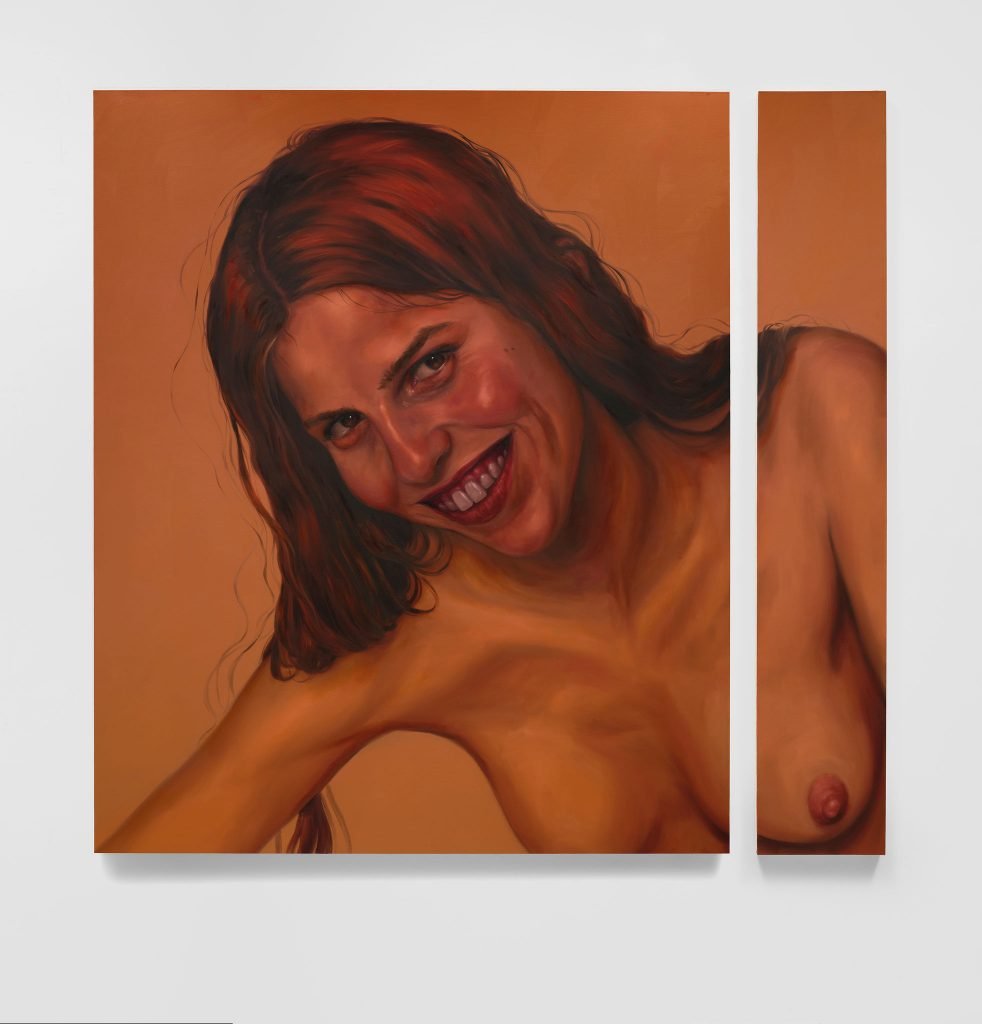
Chloe Wise, Harm’s Way (2023). © Chloe Wise. Courtesy of the Artist and Almine Rech. Photo: Thomas Barratt.
Titled Harm’s Way (2024) the painting is by artist Chloe Wise, who herself was struck by the painting’s strange aura. “I had to live with Harm’s Way to understand what it was trying to say,” Wise told me as we walked through her surprisingly tranquil midtown Manhattan studio, her cats, Hans and Pluto, wandering between paintings, during a visit earlier this spring. As with many of Wise’s figurative paintings, a friend modeled for the work.
“My friend Hayett posed for this painting,” Wise explained. “She’s a beautiful freak. When certain friends of mine pose for me they can bring exactly what I’m trying to express to an image—it’s a nuanced smile or expression that is neither happy nor sad nor angry. The voyeurism of art history and paintings of women and the figure—all that is present in their eyes. They know they’re being looked at.”
Harm’s Way is the first in a new series of paintings and sculptures by Wise in which she juxtaposes women smiling with imagery of Band-Aids. These works, made over the past year, are now on view in “Torn Clean”, which opened yesterday at Almine Rech in Brussels. The women in these paintings are brash, even unhinged, in demeanor, but the Band-Aids she adds to their bodies feel covert and are easy to overlook at first glance. They add narrative complexity to the images. We wonder: what happened there? What marked her skin? Every wound has a story.
“Torn Clean”, which marks the artist’s first major European exhibition in several years, explores new thematic and compositional territory for Wise, who is best known for her dexterously rendered figurative paintings and still lifes, as well as witty sculptures of food. Her works have often been said to embody the millennial cultural aesthetic with slick and self-aware imagery that mixes capitalist consumption with art history and satirical wit. Wise’s meteoric art world ascent began back in 2014 with her series “Bread Bags” which are sculptures of handbags in the shape of pancakes, baguettes, and challah loaf.
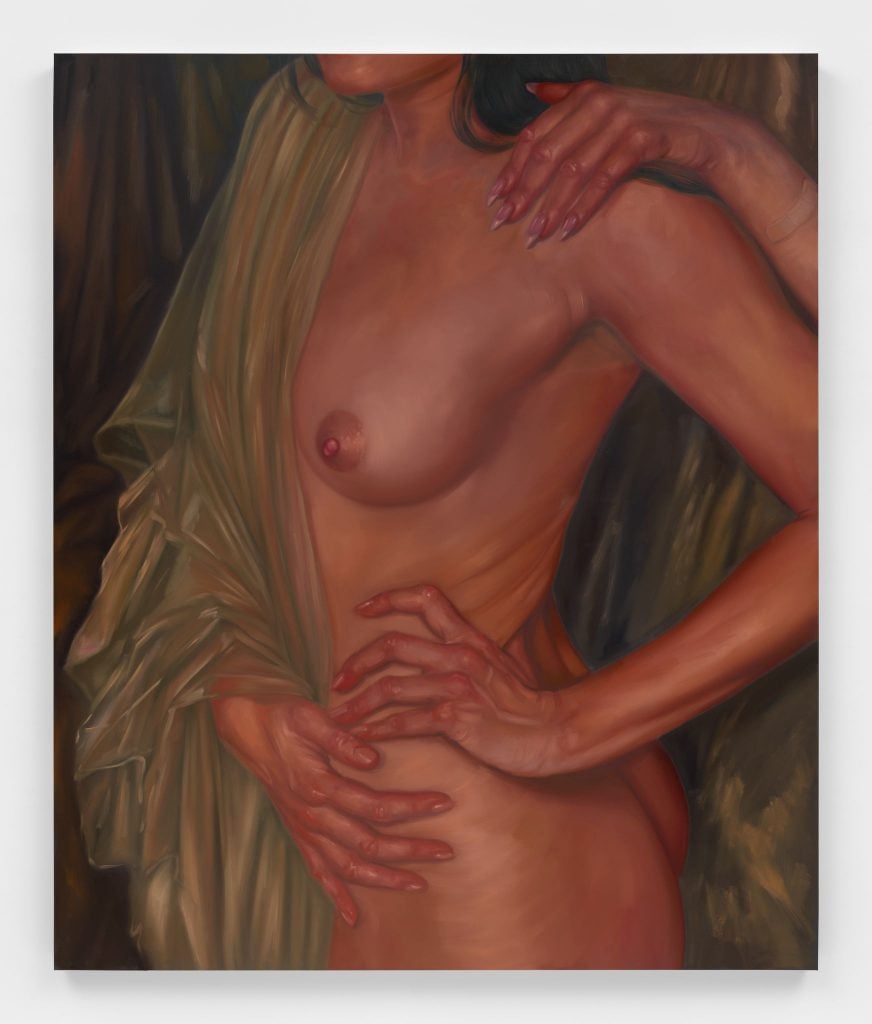
Chloe Wise, Dive into each eye and swim (2024). © Chloe Wise / Courtesy of the Artist and Almine Rech. Photo: Dan Bradica.
“Thank You for the Nice Fire“—Wise’s last exhibition with Almine Rech in 2021—explored fetishistic fixations on food and imagery of food. In her new works, Wise is after something else altogether. Food is almost entirely absent: the show includes a few still lifes of random bedside detritus, including an orange peel, a lemon, an onion, but that’s where the gastronomical imagery ends. And though Wise’s portraits of friends make up the core of the exhibition, her color palette has shifted to neutral shades of flesh.
The shift is intentional, of course, creating a kind of virtuosic blandness, a camouflage of the canvas. Women, smiling brazenly and bizarrely, in these new paintings are positioned before monochromatic backgrounds nearly the shades of their skin. Though the women in these images can appear almost maniacal, the backdrops are reminiscent of school photo shoots (in one painting, a woman holds a flower to her chest, as though in a high school yearbook). Looking closely, a Band-Aid can often subtly be found hiding on an arm or hand, such as in a work like Dive into each eye and swim.
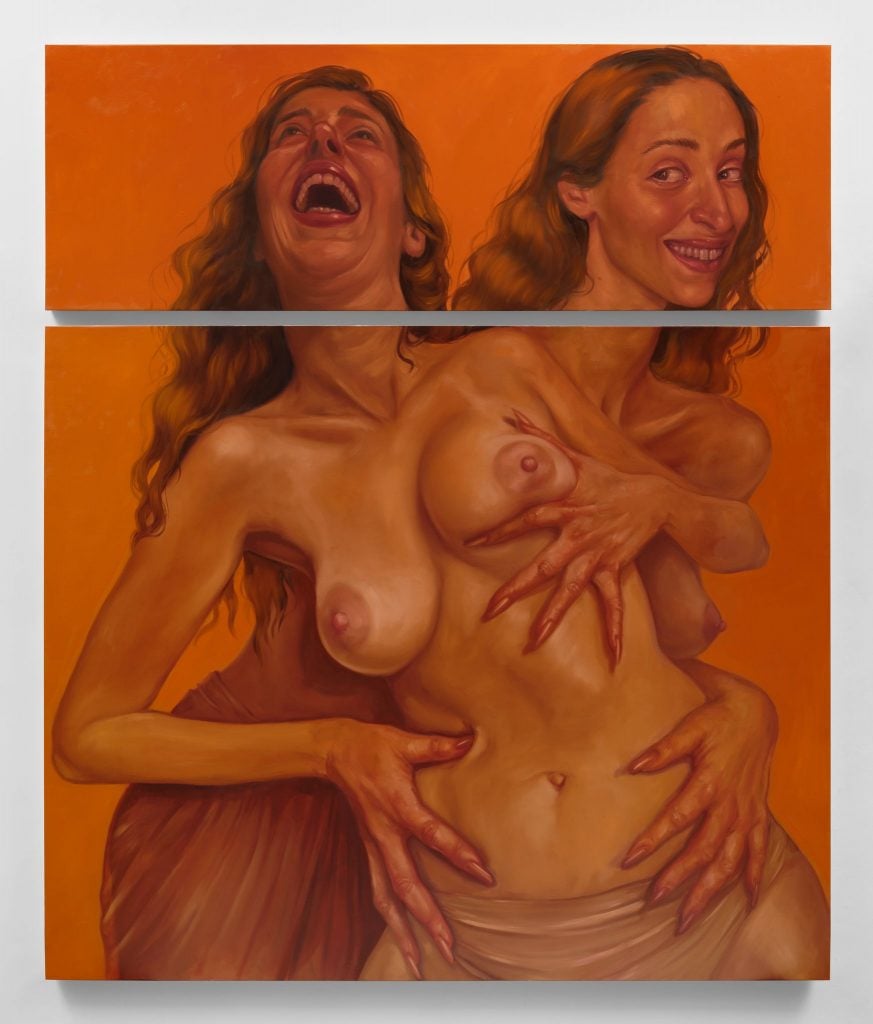
Chloe Wise, Permission deficient (2023). © Chloe Wise / Courtesy of the Artist and Almine Rech. Photo: Thomas Barratt
So, why this conflation of women’s smiles and bandages?
“The consumer item of the Band-Aid is something we’re in bodily contact with. Think about being a kid and a Band-Aid is stuck to a sleeve or you’re afraid it’s going to fall off in the pool or needing a Band-Aid and a stranger has one,” Wise explained. “I started thinking about how we’re always ignoring the reality that we walk around negotiating our inevitable mortality as fleshy persons with the potential to be bloody. The Band-Aid is the little tip of the iceberg, a palliative solution to a problem that is, at its worst, death.”
Wise points to a scar above her lip, the skin slightly shiny. “I’ve been thinking about the reality that at any moment we’re navigating walking around the world hoping we don’t break a bone, cut open our flesh, or have the life drain out of us. Smiling through life is a Band-Aid,” she explained. “It’s how we get by. I do it too.”
Wise acknowledges that the shift toward the body as an object of mortality might be offputting to some and she’s ok with that. “I have some paints that are called ‘flesh tone’—the exact same color is also sometimes called porcelet, meaning piglet, I love the grossness of that, it hints at the realness of flesh,” she said.
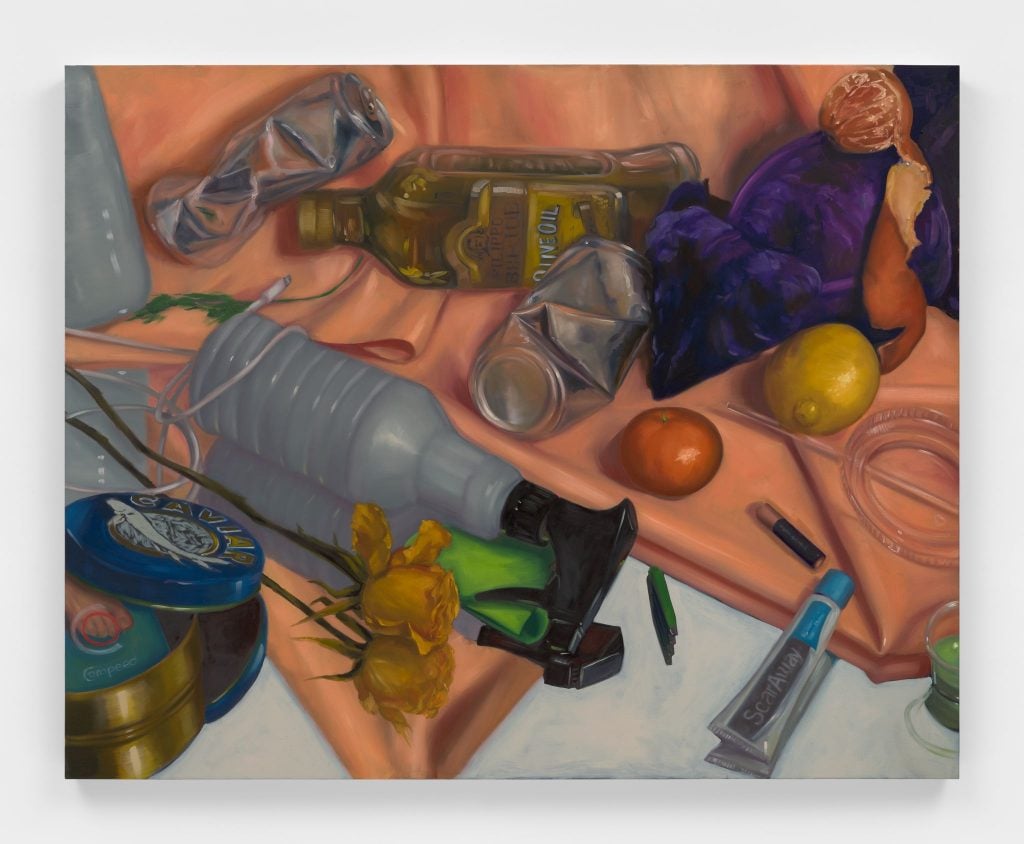
Chloe Wise, Body Part (2024). © Chloe Wise / Courtesy of the Artist and Almine Rech – Photo: Dan Bradica
Band-Aids in these paintings often appear alongside hands with long, manicured fingernails. “I thought about what other consumer products are about body mimicry. Band-Aids are fake skin. Fake eyelashes, fake nails, contacts,” she said. “We’re so quick to hide these extensions once they come loose. Then they suddenly become abject.”
For Wise, beautifying and protective qualities go hand in hand. “A smile has a similar function to a bandage in terms of dissipating a wound. Smiling is about more than showing happiness. A smile can slow the timing between an event and a violent outburst,” Wise added, glancing down at her own nails. Indeed, violence lingers around the corner in these works, and the women smiling are participants in an undefined way.
“She’s not just smiling out of joy,” said Wise looking over at one of her paintings, “Real sociopathy is when someone can smile while doing you harm. The woman smiling in this way, you wonder what kind of violence might be done to her or what might she do. Maybe it’s emotional. She’s going to fuck your life up. But there is an implied violence that is about to be done or has been done and a knowingness of how to inflict it.”
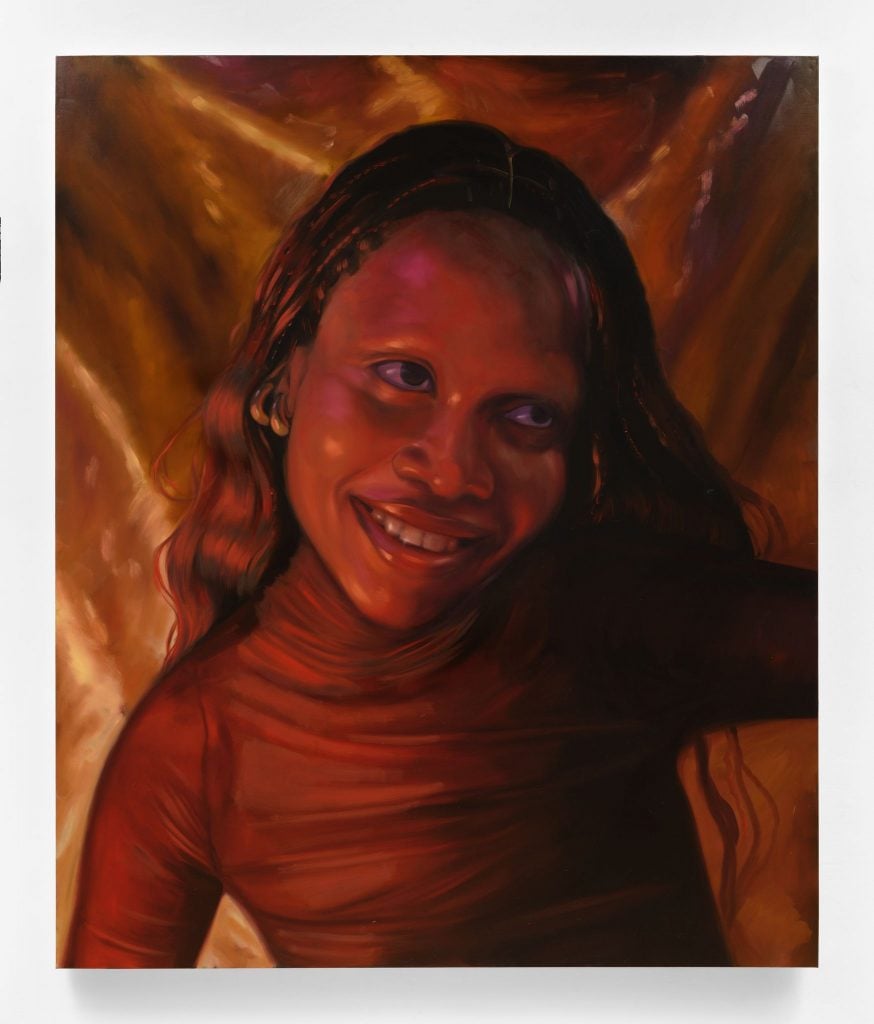
Chloe Wise, Malicious Compliance (2024). © Chloe Wise / Courtesy of the Artist and Almine Rech. Photo: Thomas Barratt
I asked Wise what the title “Torn Clean” meant to her. She started to talk, then stopped and asked me what the words meant to me, instead. “Torn clean off, a part of your body being pulled off,” I said aloud, “I think of a Band-Aid coming off quickly, but also amputation.”
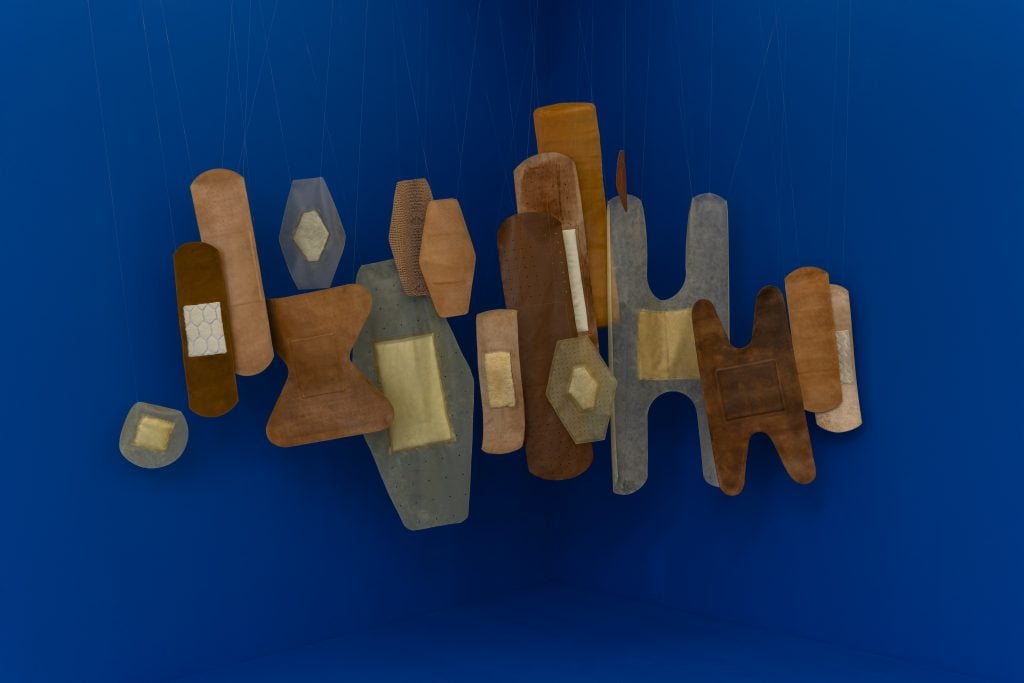
Installation view of Chloe Wise’s sculptural installation Variety Pack in “Torn Clean” at Almine Rech Brussels, 2024. © Chloe Wise. Courtesy of the artist and Almine Rech – Photo: Hugard & Vanoverschelde Photography
Wise smiled. “Exactly. It’s so violent. But those two words together, it sounds very neat, and that’s so much of how our world is packaged, to sound clean, from reporting in the newspaper to conversations with friends,” she said.
A new sculptural installation “Variety Pack” brings these disposable adhesive bandages to a monumental scale, while underscoring their physicality. “These are made from leather and shearling and latex and rubber and pony hair and like all of these skins to call into attention Band-Aids being a fake skin,” she noted, “Humans are successful in protecting our bodies because we make second skins, we make shields, we make armor. Having a thick skin is a good thing, right?”
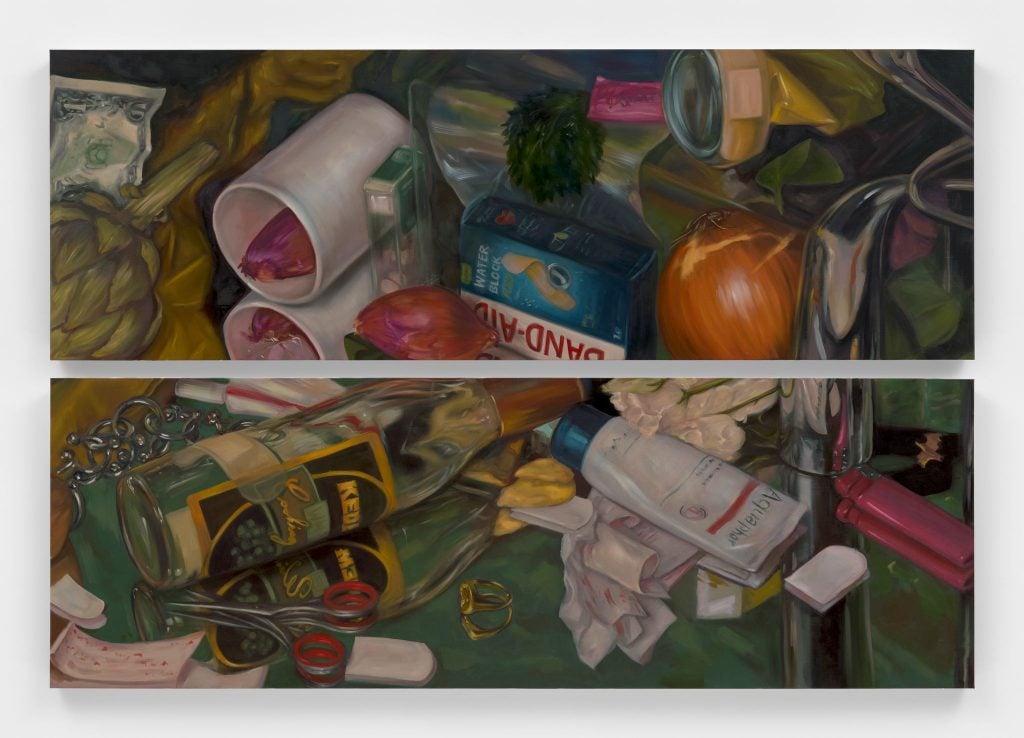
Chloe Wise, An ideal pebble, a perfect pond (2024). © Chloe Wise. Courtesy of the Artist and Almine Rech – Photo: Dan Bradica
Superficiality, the works seem to acknowledge, is a way of surviving in a society. The smiles in her paintings, Wise told me, are inherently fake. “A painting implies that this took hours and hours to make. There is no smile that lasts many hours. A smile that lasts for more than three seconds is fake,” she said. “There is no painting of a smile before the advent of photography that’s referencing the smile I’m referencing: the yearbook smile, the fake smile, the studied smile, the LinkedIn smile. The smile that is smiling for a camera. Before that smiles would’ve been fleeting,” she said. “In my paintings, people understand that they are posing for a camera. They’re being patient while the photographer gets their flash.”
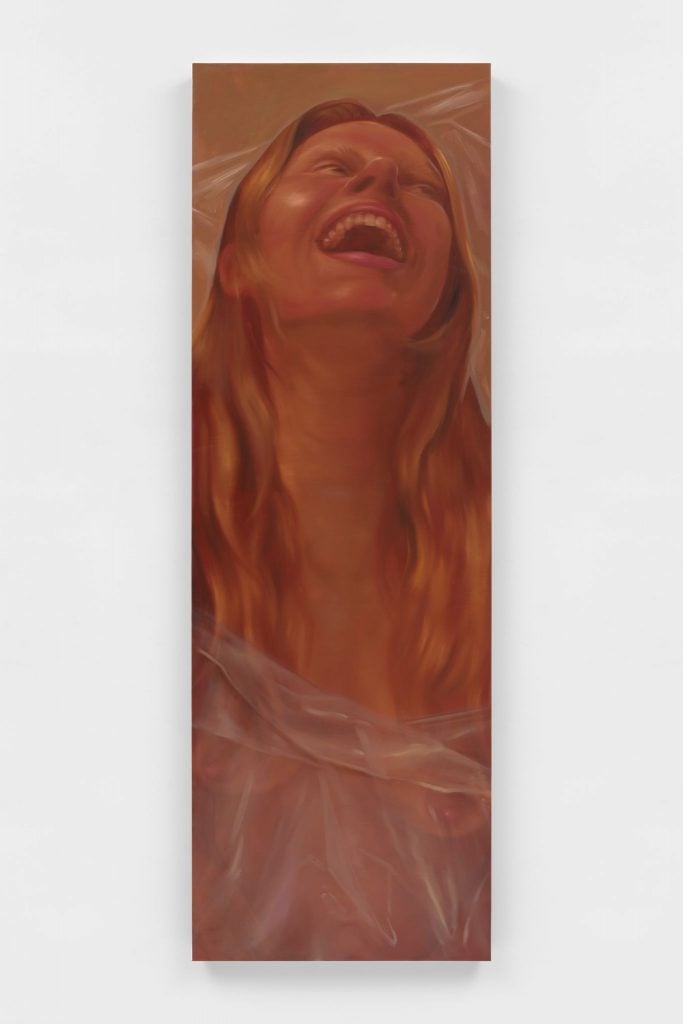
Chloe Wise, Dauntless in the trashed world (2024). © Chloe Wise. Courtesy of the Artist and Almine Rech. Photo: Dan Bradica
Were these smiles particularly American? “You know, I have friends visiting from Helsinki and London and they were surprised by how bubbly Americans are. Everyone is like ‘Amazing. Wow. You nailed it. Slay. You killed it.’” said Wise. “I always go back to Baudrillard’s America and the line about smiling—‘Smile and others will smile back. Smile to show how transparent, how candid you are.‘ Do you know it? I don’t want to misquote it.”
I did. “Smile if you have nothing to say,” Jean Baudrillard continued. “Most of all, do not hide the fact you have nothing to say nor your total indifference to others. Let this emptiness, this profound indifference shine out spontaneously in your smile.”





